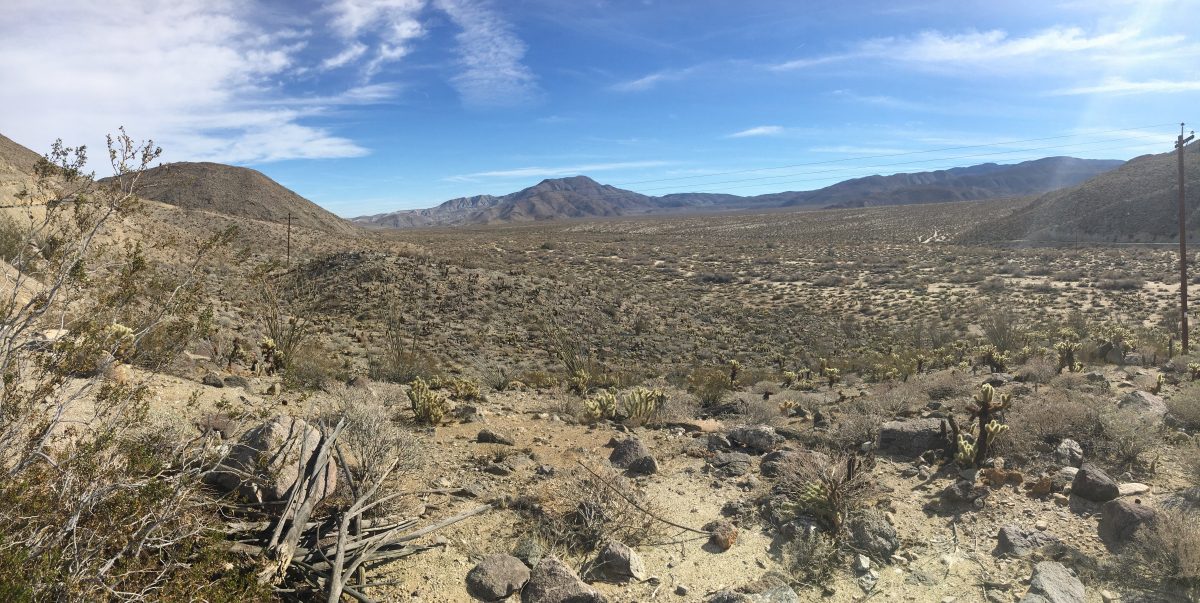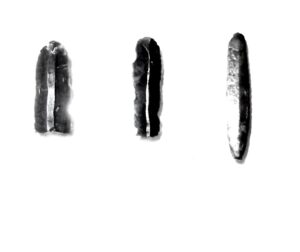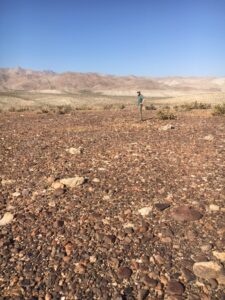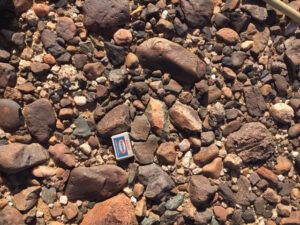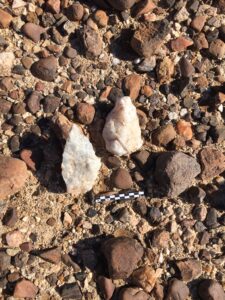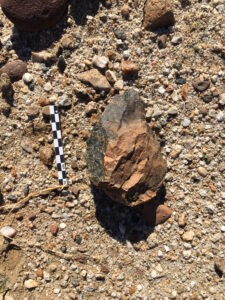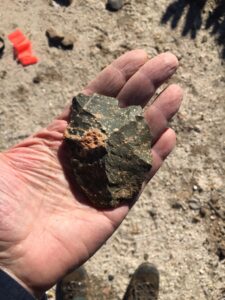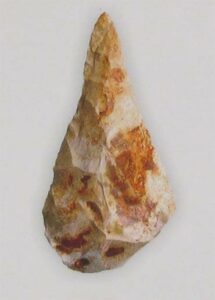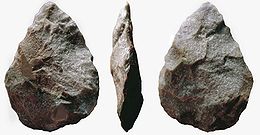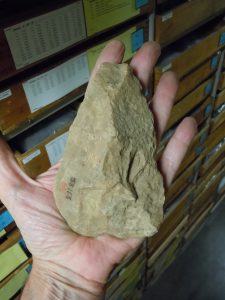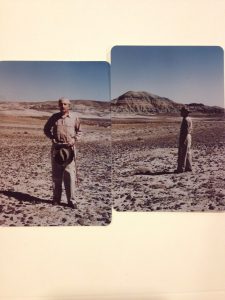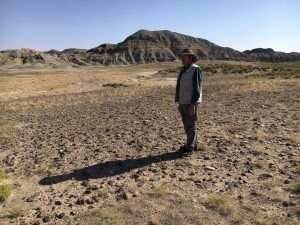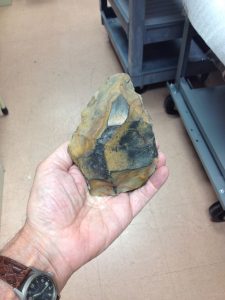A controversy concerning the existence of the American Palaeolithic has been ongoing for 150 years. The American Palaeolithic refers to the presence of anatomically modern humans or other hominin species in the western hemisphere during the Pleistocene, and the contemporary debate concerning the Clovis First and Pre-Clovis hypotheses encapsulates the controversial thinking on this topic.
The Clovis Culture with its iconic fluted projectile points was discovered as the result of the excavation of the Blackwater Draw site in New Mexico in the 1930s. It was only after 1949, however, that it was possible to date the Clovis Culture by means of the new radiocarbon method. The dates for Clovis clustered at the end of the Pleistocene about 11,500 years ago and there appeared to be no archaeological evidence for an earlier human presence in the Americas. As the dates for Clovis sites such as animal butchery sites and caches of flaked stone tools came in it also seemed that the Clovis Culture had appeared suddenly and spread rapidly. The narrow range of early dates for the rapid spread of Clovis in the United States and the overlap of this culture with the extinctions of nearly forty Pleistocene animal species was used to craft a picture of the peopling of the New World that came to be called the Clovis First hypothesis.
Clovis First is an idea with appealing simplicity that elegantly ties together a number of observed phenomena. In its textbook formulation, Clovis First traces the movements of modern humans (in the anatomical sense of modern) from an Asiatic homeland across the Beringian land bridge connecting Siberia and Alaska which was exposed during periods of low sea levels when seawater was captured in the polar ice caps and continental glaciers. People bearing the Clovis Culture were able to exploit a gap in the continental glaciers covering Canada known as the Ice Free Corridor to reach the lower 48 states of the US. It was once thought that there was only one period of time, about 12,500-11,500 years ago, when both the land bridge and the Ice Free Corridor were open to the passage of humans.
Thus a one-time event brought humans using the Clovis culture (identified primarily by flaked stone tools) through the Ice Free Corridor into the interior of North America where they encountered an abundance of wildlife unused to human predators. The Clovis population exploded and humans fanned out over the continent, eventually crossing the Isthmus of Panama and traversing South America. In an astonishingly short time, perhaps no more than 1,500 years after traversing the Ice Free Corridor, humans reached the southernmost tip of South America at Fell’s Cave in Chile (10,000 to 11,000 years ago). They had also filled all of the ecological niches between Alaska and Tierra del Fuego. In the course of this rapid expansion, Clovis hunters also wiped out more than three dozen species of megafauna (large animals like mammoths and mastodons).
These two events, the rapid peopling of the Americas and the extinction of the Pleistocene megafauna were called the Blitzkrieg and the Pleistocene Overkill hypothesis in the 1970s. The use of military terminology from World War II and the Cold War reflects the zeitgeist of the anxious decades between 1950 and 1990, but it was intended to emphasize the rapidity and uniqueness of this incursion of early humans into a pristine world. Clovis First was a compelling theory and soon became the dominant explanation for how humans came to the Americas. It continues to dominate textbooks and the public media to the present day.
There were nevertheless some archaeologists who dissented from this consensus. Archaeology textbooks published before the 1970s routinely noted the existence of sites in North America that were earlier than Clovis, even if the evidence for them was admittedly sparse and difficult to assess. So despite the popularity of the Clovis First hypothesis, archaeologists continued to search for sites that might pre-date the Clovis and which would point to an earlier wave of hominin expansion in the New World. They found evidence to support what came to be known as the Pre-Clovis hypothesis that proposed that there were humans in the Americas before—perhaps long before—the appearance of Clovis. The well-documented Meadowcroft Rockshelter near Pittsburgh, which is dated to 19,000 years ago, is an example of an accepted Pre-Clovis site in North America. George Carter, a geographer and archaeologist at the Museum of Man in San Diego, conducted fieldwork in the 1950s that convinced him that humans were present in southern California even earlier, possibly during the last Interglacial ca. 116,000-129,000 years ago. And there were other claims from southern California for really early sites, like the site of Calico near Barstow that was excavated by Louis Leakey and Ruth Simpson in the 1970s and dated to 250,000 years ago. The Pre-Clovis hypothesis and its advocates, however, were treated by Clovis Firsters with definite contempt and subjected to ad hominin attacks, despite—or perhaps because of—the glare of national publicity such as that engendered by Leakey’s participation in the Calico excavations. Before things began to change in the late 1990s, the Pre-Clovis hypothesis was rarely discussed in academic circles and was often dismissed in a quite dogmatic manner. As one of my academic advisors in the Department of Anthropology at the University of Kansas put it in 1972 when I was an undergraduate: “There is NO Pre-Clovis.” Case closed.
There things stood until 1997 when a blue ribbon committee of archaeologists examined claims for a Pre-Clovis site at Monte Verde in Chile. The excavator of the site, Thomas Dillehay, maintained that the cultural levels at Monte Verde pre-dated the North American Clovis by at least one thousand years. If Clovis was the first archaeological culture in the Americas, how could there be an occupied site as far south as Chile more than a millennium earlier? After a careful examination, the committee found no fault with Dillehay’s claims and published their findings in American Antiquity, the journal of the Society for American Archaeology, concluding that the Clovis First hypothesis would have to be revised. Once it was accepted that there was a human presence in the Americas before Clovis, it was logical to assume that early archaeological sites might be found at even much earlier periods in the Pleistocene.
Today there are two modes of thinking about this question taking shape which I call the Weak Pre-Clovis and the Strong Pre-Clovis models (a la the Anthropic Principle in cosmology).
The Weak Pre-Clovis model is a modest adjustment to the Clovis First hypothesis and is presently the most popular theory. The origins of the first Americans in northeastern Asia and their migratory pathway through Beringia to enter the Americas remain the same as for Clovis First, but the timing of the first entry is placed in or around the Last Glacial Maximum (LGM), approximately 21,000 to 27,000 years ago. Instead of a single push through an Ice Free Corridor across Canada, a maritime route south along the Pacific coast of North and South America is considered another—if not the principal—migration route allowing humans to trickle into the Americas, perhaps in three or more waves during the LGM.
Alternatively, the Strong Pre-Clovis model argues that if it was possible for humans to enter the New World in the Last Glacial Maximum—a period once considered impossible because the Ice Free Corridor was not open until the end of the Pleistocene around 12,000 years ago—then they could have arrived at almost any time in the past, so long as the coastal maritime route was available. Moreover, since anatomically modern humans are known to have been in Asia more than 120,000 years ago, it is at least possible that these humans (and perhaps other hominins who were in Asia even earlier) could have found their way into the western hemisphere. Even more intriguing is the suggestion that there may have been direct crossings of the Atlantic or Pacific Oceans during the Pleistocene. The Solutrean Hypothesis, for example, posits the movements of early humans from the area of France and Spain across the north Atlantic during the LGM following the margins of the sea ice to a landfall in the mid-Atlantic states. There is also evidence that hominins were crossing the Mediterranean more than 130,000 years ago and, at least in theory, it is possible that these seafaring hominins could have made oceanic crossings to South America. Other scholars, basing their hypothesis on genetic markers, have postulated that there were Pacific crossings from southeast Asia to South America.
New evidence supporting both the Weak and the Strong Pre-Clovis models has been published recently. Sites like Cooper’s Ferry in Idaho, which is dated to 16,000 years ago and has a flaked stone tool industry (Western Stemmed Tradition) that is different from Clovis, and White Sands in New Mexico, where human footprints have been dated to 21,000-23,000 years ago, support the Weak Pre-Clovis model. These sites have been published in high ranking peer reviewed journals and they indicate that humans were certainly resident in North America by the LGM and far south of any putative Beringian crossing. Based on this evidence it is certain that a human population must have been established in North America even earlier (on the principle that we never find the absolutely earliest sites).
The Strong Pre-Clovis model has also found support in recent years. Geochronologists, for example, have published new dates for the geologic deposits at Calico in California in which Leakey claimed to have found flaked stone tools. Their new date of 197,000 years is a minimum age for the Calico deposit and at the very least suggests that new research should be undertaken to verify the presence of artifacts in the deposits. The most important site at present is the Cerutti Mastodon Site in San Diego, California. The team studying this site believe that humans exploited the remains of a mastodon by breaking open and processing bones from the carcass using stone hammers and anvils about 130,000 years ago. This finding accords with George Carter’s discovery in the 1970s at the Texas Street site in San Diego, which is only ten miles from the Cerutti site, where he excavated flaked stone tools from within geologic deposits dated to the last Interglacial, i.e. about the same time period as Cerutti. I have examined the Texas Street artifacts and they are similar to flaked stone tool assemblages found throughout San Diego and Imperial counties in California and parts of northern Mexico. I noted that Carter wrote on several of the artifacts a note indicating that he found them embedded up to one meter in depth in the Pleistocene deposits. And finally, a team led by the late Richard McNeish in the 1990s found possible flaked stone tools in definite anthropogenic deposits in Pendejo Cave not far from White Sands that may date to as much has 75,000 years ago.
My own interest in the Pre-Clovis question took a long time to crystalize. In the 1960s I inspected an outcrop of a Pleistocene paleosol (fossil soil) in southeastern Kansas with my father who was a geologist and a specialist in that sort of thing. I was along for the ride. We were surprised to find flaked stone tools in the outcrop. My father and I looked at each other and he said “What are these doing here? This outcrop is at least 100,000 years old.” Good question, but one that we did not follow up. Then about 20 years ago I stopped at the Calico site in California on the way to Death Valley at the insistence of my wife who was curious to see a site that had been much in the news back in the 1970s. As we drove up to the site I was surprised by what I saw: a carpet of flaked stone tools, their facetted surfaces catching the early morning sun like little mirrors. There were thousands of them littering the area. What was surprising was that the only thing I knew about Calico at that time was that the “experts” claimed there were no artifacts at this site, only geofacts (naturally shaped stones). This too I stowed away in the back of my mind as a question “What are these artifacts doing here?”
My curiosity came to the fore following the controversy that greeted the publication of a book about the Solutrean Hypothesis in 2010 by Denis Stanford and Bruce Bradley. Realizing that I didn’t really know that much about the prehistory of the Americas, I decided to read the original literature on early sites in the United States. That summer I followed the trail of Pre-Clovis literature back to Calico, and George Carter, and eventually to the likes of E. B. Renaud and ultimately to the Great Palaeolithic War between C. C. Abbott and W. H. Holmes in the 1890s (see my blog posts for background). In my teaching of introductory survey courses on world prehistory, however, I had always presented the Clovis First hypothesis as the most likely model of the peopling of the New World. But after I read the primary literature I found reasons to doubt this. Because of my background as a Palaeolithic archaeologist who has worked for almost 50 years in southern Europe, I have a different perspective on this topic. The Palaeolithic occupation of Europe, for example, also had its controversy, with advocates of two different models squaring off in debate. One model known as Early Entry posited the arrival of hominins in Europe more than 1,000,000 years ago, while the Late Entry model postulated a date no earlier than 500,000 years ago. But here is the difference: archaeologists in my field tend not to argue as heatedly or to attack other archaeologists with as much venom as the Clovis Firsters do the Pre-Clovis advocates. This is not my imagination. Even the Editors of the prestigious journal Nature were obliged to scold American Clovis Firsters for their unscientific behavior in an editorial published in 2012. The wrote that “Researchers who went against that model [Clovis First] by reporting even older sites of human occupation endured brutal criticism from opponents who did not give them, or their evidence, a fair hearing. Scientists who supported the Clovis-first model countered that reports of pre-Clovis sites were examples of poor scholarship.” Colleagues in Europe, in my experience did not do this when they debated the Early and Late Entry models. Both models were taken seriously and were tested by new evidence produced by research that was carried out to find new sites, to solve questions about how to identify artifacts from geofacts, and to date the remains. (By the way, the early entry model turned out to be the correct one.)
In short, I was used to an approach where one does not assume one is right, but one evaluates competing claims with evidence. And as I read the recent Pre-Clovis literature by people such as Adovasio, Dillehay, and MacNeish, and before them, Carter and Leakey, I found claims that could be tested, and more to the point, should be tested, and not simply dismissed as “obviously” wrong. Yet many American archaeologists not only did not believe in testing the Pre-Clovis hypothesis, they actively argued against doing so!
My interest was piqued sufficiently that I decided to do a little investigation of my own. This led me to visit Pre-Clovis sites and to examine artifacts curated in museums. Eventually I would inspect materials in the Peabody Museum at Harvard, the New Jersey State Museum, the Museum of Man in San Diego, and the Museum of Anthropology at the University of Denver, as well as sites in California, Arizona, New Mexico, and Wyoming. And since 2017, I have been working with a team of colleagues to investigate possible early sites in the Anza-Borrego Desert State Park in San Diego County, California, that were found by Robert Begole in the course of several decades of survey.
I have concluded based on first-hand inspection that the flaked stone implements from Trenton to Texas Street, Calico, and Blacks Fork are artifacts of human workmanship as their discoverers claimed. They may not be Palaeolithic but it is a waste of time to try and wish them away as “geofacts.” Likewise, the geologic deposits associated with the most promising Pre-Clovis sites belong to the Pleistocene age and some are likely to be of considerable age (i.e. > 130,000 years). What I also found, however, is that evidence of flaked stone tools within early geologic deposits or in association with the remains of extinct Pleistocene fauna are difficult to document and are rarely indisputable. In my view it is not possible at this time to say whether the Strong or the Weak Pre-Clovis model is to be preferred. The evidence is not sufficient to make such a determination. But the evidence from the Cerutti Mastodon Site is very convincing, and my money is on the Strong Pre-Clovis model at the moment. Even if I have not reached a definite conclusion, my inspections tell me that the only responsible course of action is to attempt to find good sites and to excavate then and date them. This is the only way to determine which model of the Pre-Clovis will ultimately prevail.
Debates should continue, and archaeologists should desist from blanket assertions, ad hominin attacks, and out-and-out denial of possibilities and engage instead in long-term, structured research projects aimed at identifying early sites and evaluating their contexts in as thorough a manner as possible. Again I quote the Editors of Nature: “Researchers must always consider that they might be wrong, and should look carefully at opposing data and conclusions. At the same time, scientists who make bold claims must marshal an extraordinary case, especially if they seek to topple a dominant model built on many previous studies. Such prescriptions sound obvious, but many scientists forget them, particularly in fields with limited data, such as archaeology.”
Take one example of what I mean. The publication of the Cerutti Mastodon Site in 2017 led to an outpouring of commentary and—let’s face it—posturing, about the veracity of the results. Follow up research on the site continues, but what seems obvious to me is that archaeologists of all stripes should now target 130,000-year old geologic deposits throughout the Americas and search them for sites. This approach to research has been advocated for many decades by a wide range of archaeologists and geoarchaeologists (see Holcomb et al. for a summary). It is not a new idea. If humans were in the Americas at an early date the evidence will be there in the deposits of the right age, but we cannot know whether it is there—or it isn’t—unless we go and look.
Further Reading
Adovasio, J., and D. Pedlar, 2016, Strangers in a New Land: What Archaeology Reveals About the First Americans. Firefly Books.
Bennett, M. R., et al., 2021, “Evidence of humans in North America during the Last Glacial Maximum,” Science 373: 1528-1531.
Carter, G. F., 1957, Pleistocene Man at San Diego. Johns Hopkins University Press.
Davis, L., et al., 2019, “Late Upper Paleolithic occupation at Cooper’s Ferry, Idaho, USA, ~16,000 years ago,” Science 365 (6456) pp. 891-897. DOI: 10.1126/science.aax9830
Editors, 2012, “Young Americans: the rancorous debate over when people first arrived in America has not helped science,” Nature 485 (6). https://doi.org/10.1038/485006b
Holcomb, J., et al., 2020, “Deposit-centered archaeological survey and the search for the Aegean Palaeolithic: A geoarchaeological perspective,” Quaternary International 550: 169-183. https://doi.org/10.1016/j.quaint.2020.04.043
Holen, S., at al., 2017, “A 130,000-year-old archaeological site in southern California, USA,”
Nature 544: 479-483. https://doi.org/10.1038/nature22065
MacNeish, R., and J. G. Libby, 2003, Pendejo Cave. University of New Mexico Press.
Meltzer, D., et al., 1997, “On the Pleistocene Antiquity of Monte Verde, Southern Chile,” American Antiquity 62 (4): 659-663. https://doi.org/10.2307/281884
Owen, L. A., et al., 2011, “Surface ages and rates of erosion at the Calico Archaeological Site in the Mojave Desert, Southern California,” Geomorphology 125: 40-50.
Stanford, D., and B. Bradley, 2010, Across Atlantic Ice: The Origin of America’s Clovis Culture. University of California at Berkeley Press.
